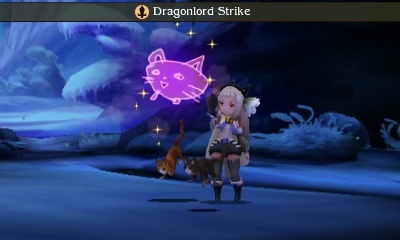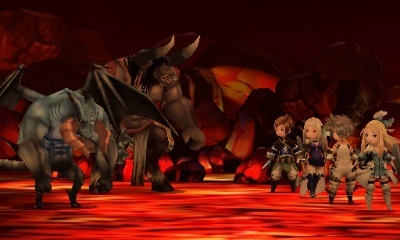Bravely Second: End Layer (Nintendo 3DS) Review
By Az Elias  18.03.2016
18.03.2016

Bravely Default was a near-triumph for Silicon Studio and Square Enix. A spiritual successor to Final Fantasy: The 4 Heroes of Light, it was the classic turn-based JRPG the older generation had been clamouring for for years…in terms of its battle system. Things took a drastic change for the worse once the final chapters rolled into play, both story- and gameplay-wise. With the sequel, Bravely Second: End Layer, there has been time to correct the initial wrongs that let the original down slightly; did the team manage it?
Bravely Second retreads a lot of old ground from Bravely Default in more ways than one. From revisiting the same locations, to the return of many characters both friend and foe, to the familiar head-blagging multiple universe plotline that wasn't put into effect in the most fun way possible in the original title, much has been seen before, having both positive and negative effects.
Thankfully, what is one of the greatest turn-based battle systems in the genre is back in full flow, with a range of generous options that help to make the gameplay much more user-friendly and almost act as gifts to those with plenty of experience with RPGs. Simply tapping left and right on the D-pad speeds up and down the animations, which is perfect for grinding and just bashing through the game at pace in general. Then there is the autobattle setting that allows for up to three different personally tailored command sets, which again can be put to use when refighting the same enemies for reward boosting, applying buffs or health boosts to the party, or inflicting status ailments on foes. Whether in battle or out of it, autobattle settings can be picked at any time. In a similar fashion, party job sets can be saved into a favourites list, saving more time going into menus and equipping and removing jobs and abilities.

Grinding itself is taken to a new level. If the party wins a battle in one turn, without the enemy having any reply, the option to fight another battle with greater EXP, Job Points and money as the reward is offered. This stacks each time victory is achieved, as long as the enemy never gets a turn in. The catch is that the number of turns left for the heroes at the end of each fight isn't refreshed to normal, until the enemy naturally gets its chance to attack. It's an efficient, speedy and all-around brilliant idea that ensures grinding doesn't fall quite into the same tedious trap that just about every other RPG does.
Of course, the enemy encounter rate can again be adjusted through a variety of frequency levels, including turning them off entirely, allowing players to concentrate solely on tackling dungeons and traversing the world map with ease. Difficulty settings can also be applied, and even allow for the turning off of post-battle rewards, such as EXP and money. All text and cut-scenes are completely skippable on top of this. Like Bravely Default before it, Bravely Second sets the standard for the accessibility options that should be present in all games of this ilk, making for an incredibly smooth and more enjoyable ride, and gives the chance for veteran RPG fans to test their limits with the various handicaps. Perhaps the only feature missing is a text log for those times dialogue is accidentally brushed over.
Combined with the wonderful job system of the Final Fantasy of old, the cream of the crop in this adventure is easily the customisable character options and free approach to setting up the party in exciting battles. What sets this apart from other job system-type RPGs is how players are expected to go out of their way in small side-quests in order to gain access to the majority of the costumes on offer. Following the main storyline branch is entirely possible, but to stand the best chance of overcoming the toughest foes and boss battles, venturing beyond the normal path to the location of important characters that hold the "asterisks" that wield the special job types inside them is necessary.

These missions usually involve a bit of backstory to the characters from the last game, but new faces also exist, and generally play out with two asterisk holders holding differing viewpoints on a current problematic situation. Siding with whichever character results in a fight against the other, ultimately rewarding with that person's job class. Taking into account which job is sought after the most, making choices that you don't necessarily agree with is often called for, but every job can eventually be won later in the game…albeit against a stronger foe.
The range of jobs that can be unlocked is massive, including familiar mage types and returning ones from Bravely Default, such as Valkyrie, Pirate and Swordmaster, but also introduced are some of the slightly more bizarre and humorous outfits, like Exorcist (reverts targets to a previous state, undoing damage, status effects and KOs), Catmancer (acts like a blue mage, learning and using the skills of enemies, but puts the characters in cute cat costumes), and Guardian (a defensive damage taker that can possess foes and allies alike to use their abilities). Mixing and matching the abilities of one job in tandem with a primary role brings up all sorts of possibilities, with certain match-ups working more favourably than others. The combinations are large, and players can test these out at will in order to find the best and most effective set-ups for particular encounters.
For anyone that is unfamiliar with the battle system, it's a clever, but simple, concept. Each character can opt to "Brave" and take its turn by attacking or using an ability, but by using "Default," the hero will skip its turn, settle for a defensive state, and gain an extra turn next time around, allowing for two moves to be made at once. Defaulting can be done multiple times to allow for more commands to be made together, but it is also entirely possible to go all out and Brave up to four times from the get-go. The consequence is that character then being inactive until just as many rounds of turns play out amongst all targets. This opens up all sorts of tactical risk-reward gameplay, and with the AI using the Brave-Default system a lot better than before, working around how the enemy plays its defensive and offensive game is the key to victory.

Dungeons are slightly lacking on the puzzle side of things. There is plenty of lever flicking and switch hitting to open doors and raise platforms, but there's nothing too taxing or memorable. They still have that old-school feel to them, with hidden walls that lead to treasure, and some new camera angles that aren't strictly top-down do provide a more pleasant look at the locales as a whole, which is also enhanced further with the 3D effect, and is put to use extremely well once again. The returning hand-drawn graphics are lovely, creating a style that didn't seem possible on 3DS, and the whimsical chibi characters are very expressionistic, reacting and altering poses and animations to lines spoken in timely fashion.
It all sounds rosy enough, but it's the narrative that sadly kicks Bravely Second down a notch or two. Perhaps the intended goal was always to go for a comedic slant, but this feels far too try-hard. Serious moments can't be taken as such when mentions of gravy keep being poured into the dialogue, and main character Yew's (yes, he is called Yew, and makes for the ridiculous-sounding lines that you'd expect) Shaggy voice, Magnolia's overly-used French phrases, and the awful compressed audio for what seems like only the girls' voices when they speak anything with an S sound in it quickly become extremely jarring. The new pronunciation of Edea's name is also difficult to grasp.
The plot and dialogue itself is littered with one too many clichés, cringe moments and what feels like something too similar to its predecessor. Coupled with the aforementioned issues, it is hard to remain invested and immersed. Revisiting the same world and locations has paved way for some nostalgic periods with characters, but that exciting adventurous feeling is lost without more new areas and perhaps an entirely different world map to explore.

Cubed3 Rating
Very Good - Bronze Award

If it weren't for the utterly brilliant turn-based battle system, freely customisable characters through new and old job types, and the breadth of accessible options that enhance the RPG experience tenfold, Bravely Second would be held in lower esteem, since the narrative that tries too much to hit comical notes and lacks a core that sets itself apart from other role-playing storylines is disappointing. There are some clever ideas thrown in that try to improve on the original game's plot, along with a handful of entertaining characters in amongst the obnoxious ones, as well as great use of 3D, but End Layer should be played for its battle and job systems first and foremost, provided the original title was enjoyed.
Bravely Second: End Layer can be bought from Play-Asia.com today in 3DS card format, or digital eShop codes can easily be purchased for any region.

![]() 7/10
7/10
![]() 0
(0 Votes)
0
(0 Votes)
 Out now
Out now  Out now
Out now  Out now
Out now  Out now Also on
Out now Also on 
Comments
Comments are currently disabled

 Sign In
Sign In Game Details
Game Details Subscribe to this topic
Subscribe to this topic Features
Features





 Top
Top

